BMP3004 Report: Understanding Motivation & Workplace Factors
VerifiedAdded on 2023/06/14
|9
|2066
|277
Report
AI Summary
This report delves into the multifaceted nature of employee motivation within organizations, examining both intrinsic and extrinsic factors that influence individual engagement and productivity. It analyzes the impact of various elements such as salary, promotion opportunities, and the work environment, while also considering the positive experiences like opportunities for growth and flexibility, and negative experiences such as workplace conflicts and poor management. Drawing upon Maslow's hierarchy of needs, the report highlights the importance of fulfilling physiological, safety, belongingness, esteem, and self-actualization needs to foster a motivated workforce. Furthermore, it proposes effective strategies for mitigating negative factors and cultivating a positive work environment that promotes employee retention and overall organizational success. The report concludes by emphasizing the need for managers and leaders to prioritize employee well-being and create a supportive atmosphere where individuals feel valued and empowered.
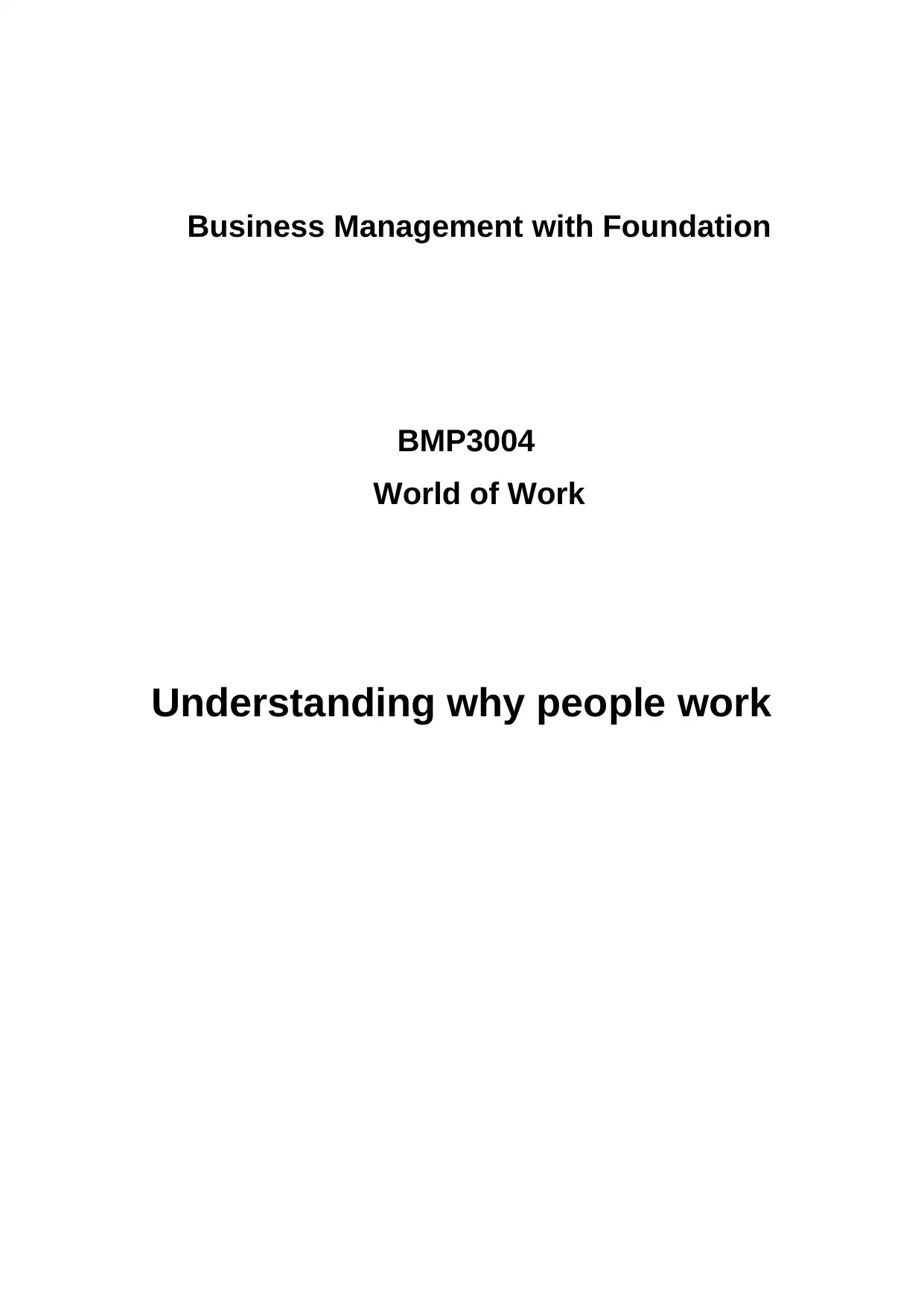
Business Management with Foundation
BMP3004
World of Work
Understanding why people work
BMP3004
World of Work
Understanding why people work
Paraphrase This Document
Need a fresh take? Get an instant paraphrase of this document with our AI Paraphraser
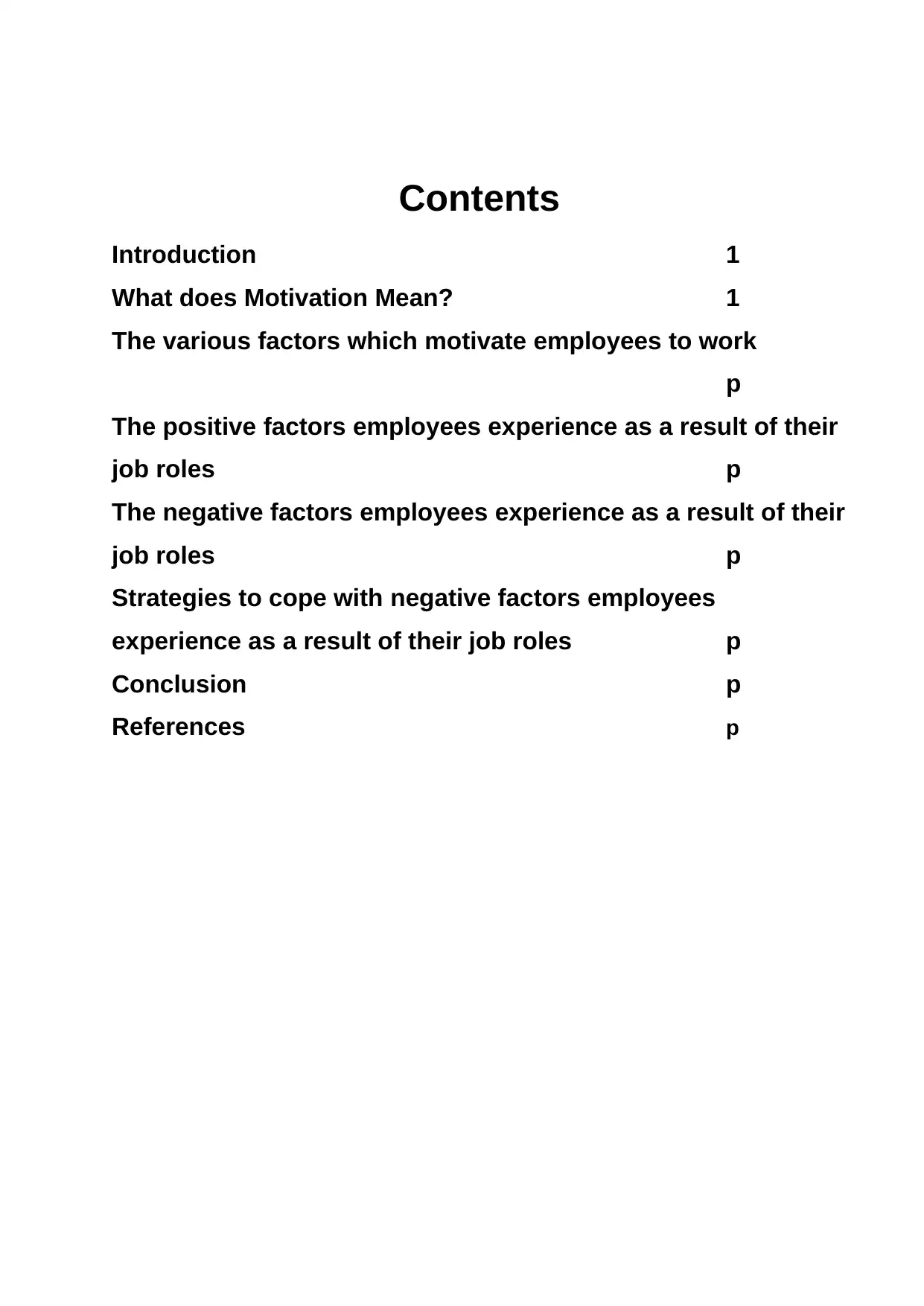
Contents
Introduction 1
What does Motivation Mean? 1
The various factors which motivate employees to work
p
The positive factors employees experience as a result of their
job roles p
The negative factors employees experience as a result of their
job roles p
Strategies to cope with negative factors employees
experience as a result of their job roles p
Conclusion p
References p
Introduction 1
What does Motivation Mean? 1
The various factors which motivate employees to work
p
The positive factors employees experience as a result of their
job roles p
The negative factors employees experience as a result of their
job roles p
Strategies to cope with negative factors employees
experience as a result of their job roles p
Conclusion p
References p

⊘ This is a preview!⊘
Do you want full access?
Subscribe today to unlock all pages.

Trusted by 1+ million students worldwide
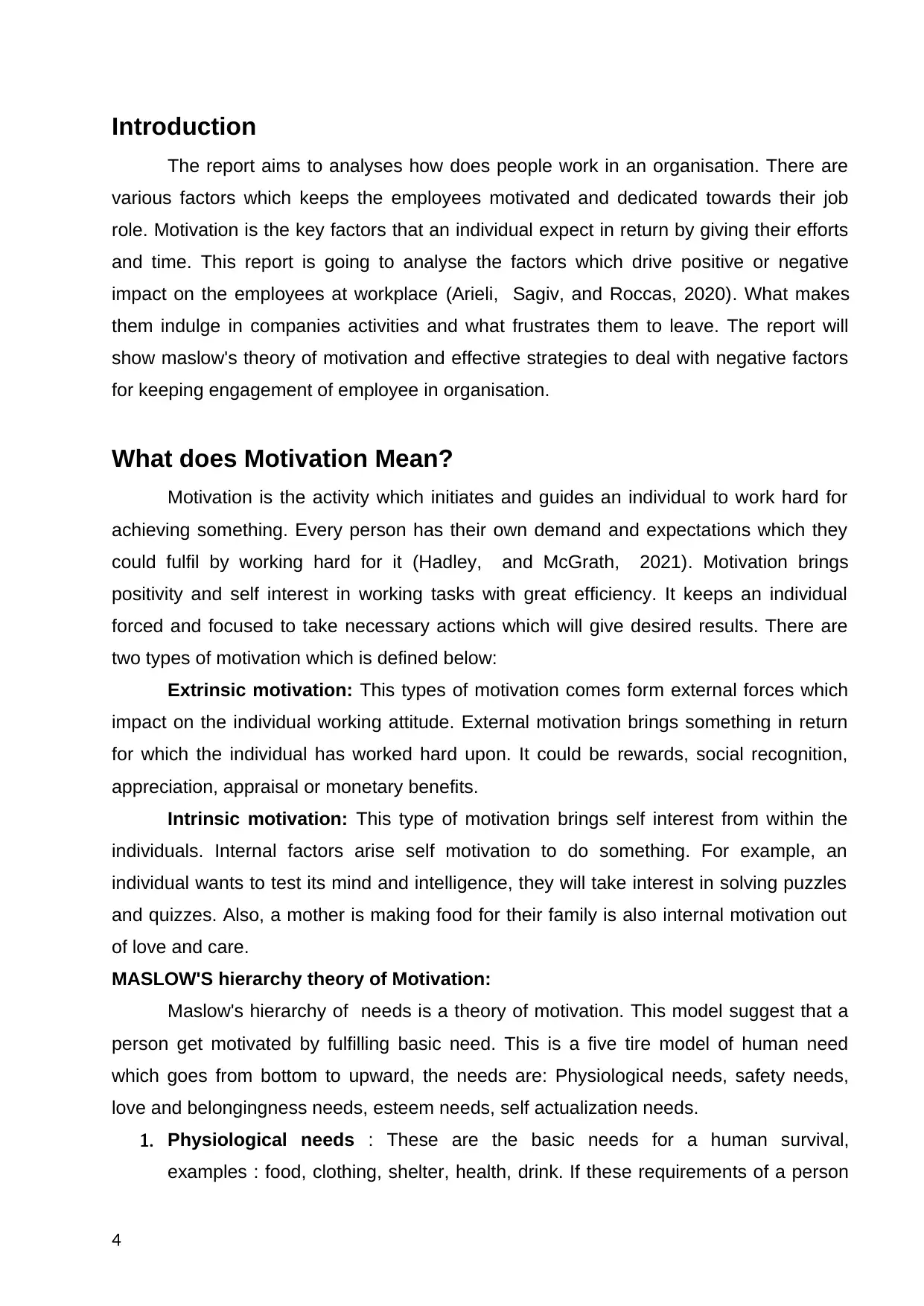
Introduction
The report aims to analyses how does people work in an organisation. There are
various factors which keeps the employees motivated and dedicated towards their job
role. Motivation is the key factors that an individual expect in return by giving their efforts
and time. This report is going to analyse the factors which drive positive or negative
impact on the employees at workplace (Arieli, Sagiv, and Roccas, 2020). What makes
them indulge in companies activities and what frustrates them to leave. The report will
show maslow's theory of motivation and effective strategies to deal with negative factors
for keeping engagement of employee in organisation.
What does Motivation Mean?
Motivation is the activity which initiates and guides an individual to work hard for
achieving something. Every person has their own demand and expectations which they
could fulfil by working hard for it (Hadley, and McGrath, 2021). Motivation brings
positivity and self interest in working tasks with great efficiency. It keeps an individual
forced and focused to take necessary actions which will give desired results. There are
two types of motivation which is defined below:
Extrinsic motivation: This types of motivation comes form external forces which
impact on the individual working attitude. External motivation brings something in return
for which the individual has worked hard upon. It could be rewards, social recognition,
appreciation, appraisal or monetary benefits.
Intrinsic motivation: This type of motivation brings self interest from within the
individuals. Internal factors arise self motivation to do something. For example, an
individual wants to test its mind and intelligence, they will take interest in solving puzzles
and quizzes. Also, a mother is making food for their family is also internal motivation out
of love and care.
MASLOW'S hierarchy theory of Motivation:
Maslow's hierarchy of needs is a theory of motivation. This model suggest that a
person get motivated by fulfilling basic need. This is a five tire model of human need
which goes from bottom to upward, the needs are: Physiological needs, safety needs,
love and belongingness needs, esteem needs, self actualization needs.
1. Physiological needs : These are the basic needs for a human survival,
examples : food, clothing, shelter, health, drink. If these requirements of a person
4
The report aims to analyses how does people work in an organisation. There are
various factors which keeps the employees motivated and dedicated towards their job
role. Motivation is the key factors that an individual expect in return by giving their efforts
and time. This report is going to analyse the factors which drive positive or negative
impact on the employees at workplace (Arieli, Sagiv, and Roccas, 2020). What makes
them indulge in companies activities and what frustrates them to leave. The report will
show maslow's theory of motivation and effective strategies to deal with negative factors
for keeping engagement of employee in organisation.
What does Motivation Mean?
Motivation is the activity which initiates and guides an individual to work hard for
achieving something. Every person has their own demand and expectations which they
could fulfil by working hard for it (Hadley, and McGrath, 2021). Motivation brings
positivity and self interest in working tasks with great efficiency. It keeps an individual
forced and focused to take necessary actions which will give desired results. There are
two types of motivation which is defined below:
Extrinsic motivation: This types of motivation comes form external forces which
impact on the individual working attitude. External motivation brings something in return
for which the individual has worked hard upon. It could be rewards, social recognition,
appreciation, appraisal or monetary benefits.
Intrinsic motivation: This type of motivation brings self interest from within the
individuals. Internal factors arise self motivation to do something. For example, an
individual wants to test its mind and intelligence, they will take interest in solving puzzles
and quizzes. Also, a mother is making food for their family is also internal motivation out
of love and care.
MASLOW'S hierarchy theory of Motivation:
Maslow's hierarchy of needs is a theory of motivation. This model suggest that a
person get motivated by fulfilling basic need. This is a five tire model of human need
which goes from bottom to upward, the needs are: Physiological needs, safety needs,
love and belongingness needs, esteem needs, self actualization needs.
1. Physiological needs : These are the basic needs for a human survival,
examples : food, clothing, shelter, health, drink. If these requirements of a person
4
Paraphrase This Document
Need a fresh take? Get an instant paraphrase of this document with our AI Paraphraser
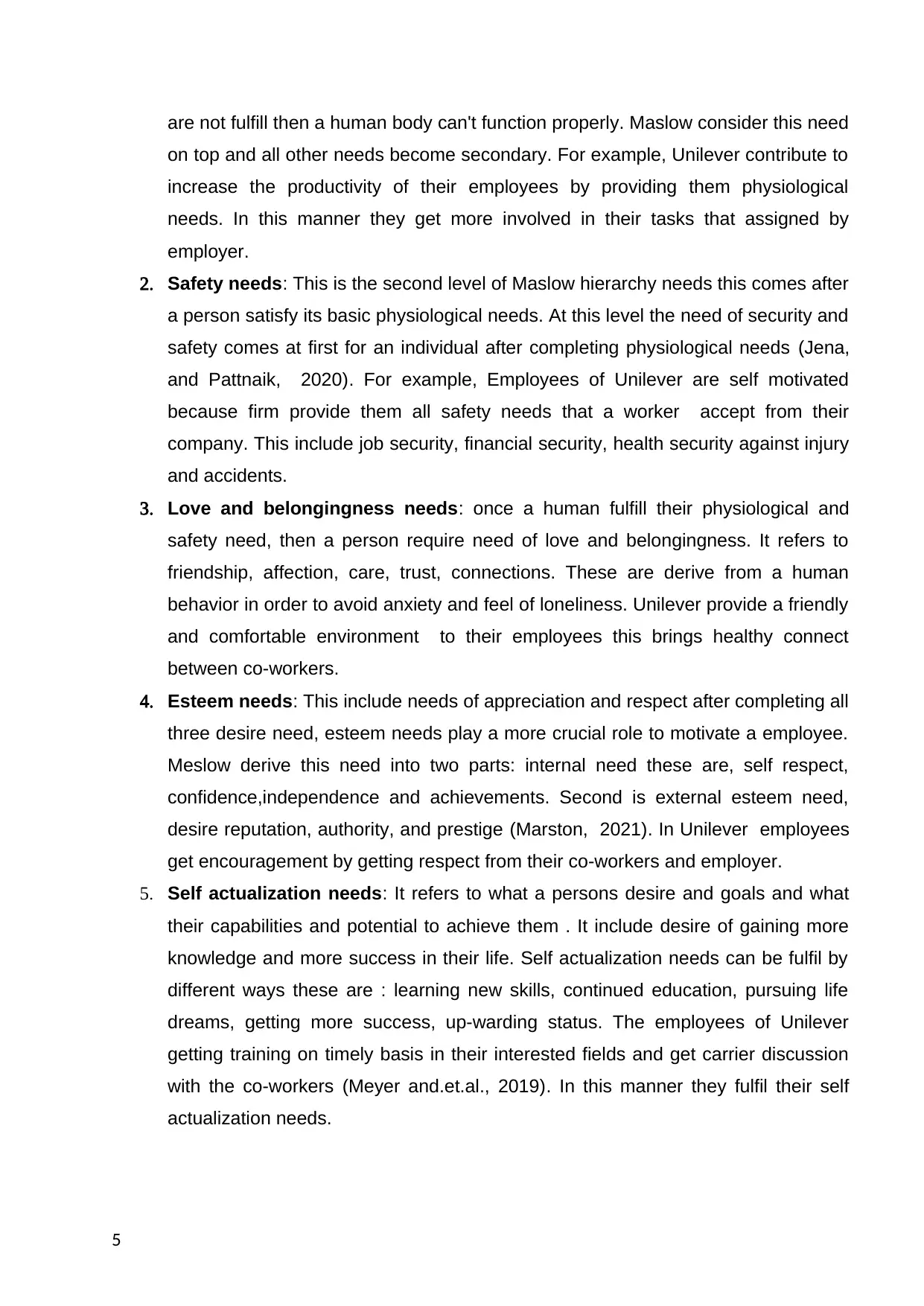
are not fulfill then a human body can't function properly. Maslow consider this need
on top and all other needs become secondary. For example, Unilever contribute to
increase the productivity of their employees by providing them physiological
needs. In this manner they get more involved in their tasks that assigned by
employer.
2. Safety needs: This is the second level of Maslow hierarchy needs this comes after
a person satisfy its basic physiological needs. At this level the need of security and
safety comes at first for an individual after completing physiological needs (Jena,
and Pattnaik, 2020). For example, Employees of Unilever are self motivated
because firm provide them all safety needs that a worker accept from their
company. This include job security, financial security, health security against injury
and accidents.
3. Love and belongingness needs: once a human fulfill their physiological and
safety need, then a person require need of love and belongingness. It refers to
friendship, affection, care, trust, connections. These are derive from a human
behavior in order to avoid anxiety and feel of loneliness. Unilever provide a friendly
and comfortable environment to their employees this brings healthy connect
between co-workers.
4. Esteem needs: This include needs of appreciation and respect after completing all
three desire need, esteem needs play a more crucial role to motivate a employee.
Meslow derive this need into two parts: internal need these are, self respect,
confidence,independence and achievements. Second is external esteem need,
desire reputation, authority, and prestige (Marston, 2021). In Unilever employees
get encouragement by getting respect from their co-workers and employer.
5. Self actualization needs: It refers to what a persons desire and goals and what
their capabilities and potential to achieve them . It include desire of gaining more
knowledge and more success in their life. Self actualization needs can be fulfil by
different ways these are : learning new skills, continued education, pursuing life
dreams, getting more success, up-warding status. The employees of Unilever
getting training on timely basis in their interested fields and get carrier discussion
with the co-workers (Meyer and.et.al., 2019). In this manner they fulfil their self
actualization needs.
5
on top and all other needs become secondary. For example, Unilever contribute to
increase the productivity of their employees by providing them physiological
needs. In this manner they get more involved in their tasks that assigned by
employer.
2. Safety needs: This is the second level of Maslow hierarchy needs this comes after
a person satisfy its basic physiological needs. At this level the need of security and
safety comes at first for an individual after completing physiological needs (Jena,
and Pattnaik, 2020). For example, Employees of Unilever are self motivated
because firm provide them all safety needs that a worker accept from their
company. This include job security, financial security, health security against injury
and accidents.
3. Love and belongingness needs: once a human fulfill their physiological and
safety need, then a person require need of love and belongingness. It refers to
friendship, affection, care, trust, connections. These are derive from a human
behavior in order to avoid anxiety and feel of loneliness. Unilever provide a friendly
and comfortable environment to their employees this brings healthy connect
between co-workers.
4. Esteem needs: This include needs of appreciation and respect after completing all
three desire need, esteem needs play a more crucial role to motivate a employee.
Meslow derive this need into two parts: internal need these are, self respect,
confidence,independence and achievements. Second is external esteem need,
desire reputation, authority, and prestige (Marston, 2021). In Unilever employees
get encouragement by getting respect from their co-workers and employer.
5. Self actualization needs: It refers to what a persons desire and goals and what
their capabilities and potential to achieve them . It include desire of gaining more
knowledge and more success in their life. Self actualization needs can be fulfil by
different ways these are : learning new skills, continued education, pursuing life
dreams, getting more success, up-warding status. The employees of Unilever
getting training on timely basis in their interested fields and get carrier discussion
with the co-workers (Meyer and.et.al., 2019). In this manner they fulfil their self
actualization needs.
5
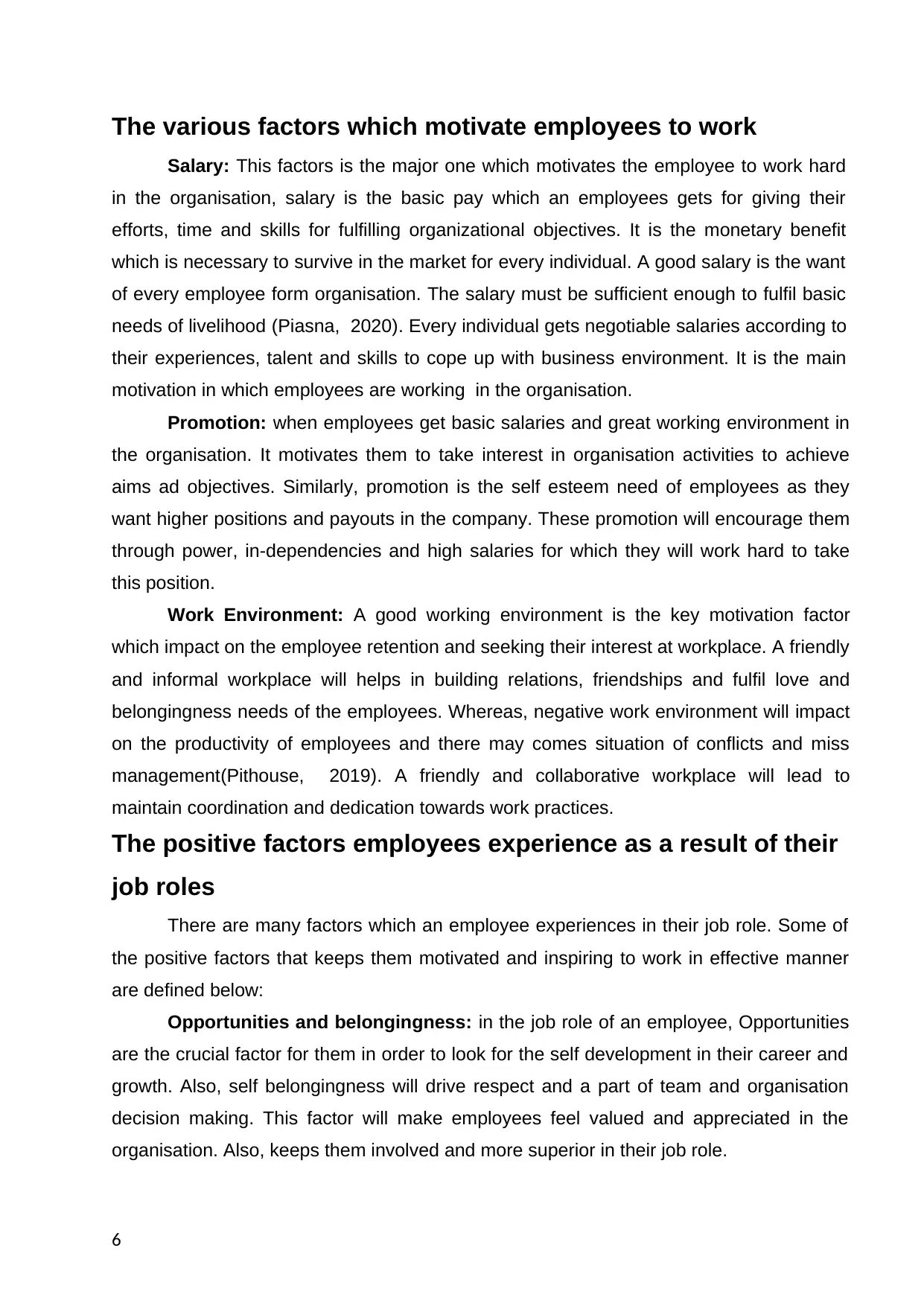
The various factors which motivate employees to work
Salary: This factors is the major one which motivates the employee to work hard
in the organisation, salary is the basic pay which an employees gets for giving their
efforts, time and skills for fulfilling organizational objectives. It is the monetary benefit
which is necessary to survive in the market for every individual. A good salary is the want
of every employee form organisation. The salary must be sufficient enough to fulfil basic
needs of livelihood (Piasna, 2020). Every individual gets negotiable salaries according to
their experiences, talent and skills to cope up with business environment. It is the main
motivation in which employees are working in the organisation.
Promotion: when employees get basic salaries and great working environment in
the organisation. It motivates them to take interest in organisation activities to achieve
aims ad objectives. Similarly, promotion is the self esteem need of employees as they
want higher positions and payouts in the company. These promotion will encourage them
through power, in-dependencies and high salaries for which they will work hard to take
this position.
Work Environment: A good working environment is the key motivation factor
which impact on the employee retention and seeking their interest at workplace. A friendly
and informal workplace will helps in building relations, friendships and fulfil love and
belongingness needs of the employees. Whereas, negative work environment will impact
on the productivity of employees and there may comes situation of conflicts and miss
management(Pithouse, 2019). A friendly and collaborative workplace will lead to
maintain coordination and dedication towards work practices.
The positive factors employees experience as a result of their
job roles
There are many factors which an employee experiences in their job role. Some of
the positive factors that keeps them motivated and inspiring to work in effective manner
are defined below:
Opportunities and belongingness: in the job role of an employee, Opportunities
are the crucial factor for them in order to look for the self development in their career and
growth. Also, self belongingness will drive respect and a part of team and organisation
decision making. This factor will make employees feel valued and appreciated in the
organisation. Also, keeps them involved and more superior in their job role.
6
Salary: This factors is the major one which motivates the employee to work hard
in the organisation, salary is the basic pay which an employees gets for giving their
efforts, time and skills for fulfilling organizational objectives. It is the monetary benefit
which is necessary to survive in the market for every individual. A good salary is the want
of every employee form organisation. The salary must be sufficient enough to fulfil basic
needs of livelihood (Piasna, 2020). Every individual gets negotiable salaries according to
their experiences, talent and skills to cope up with business environment. It is the main
motivation in which employees are working in the organisation.
Promotion: when employees get basic salaries and great working environment in
the organisation. It motivates them to take interest in organisation activities to achieve
aims ad objectives. Similarly, promotion is the self esteem need of employees as they
want higher positions and payouts in the company. These promotion will encourage them
through power, in-dependencies and high salaries for which they will work hard to take
this position.
Work Environment: A good working environment is the key motivation factor
which impact on the employee retention and seeking their interest at workplace. A friendly
and informal workplace will helps in building relations, friendships and fulfil love and
belongingness needs of the employees. Whereas, negative work environment will impact
on the productivity of employees and there may comes situation of conflicts and miss
management(Pithouse, 2019). A friendly and collaborative workplace will lead to
maintain coordination and dedication towards work practices.
The positive factors employees experience as a result of their
job roles
There are many factors which an employee experiences in their job role. Some of
the positive factors that keeps them motivated and inspiring to work in effective manner
are defined below:
Opportunities and belongingness: in the job role of an employee, Opportunities
are the crucial factor for them in order to look for the self development in their career and
growth. Also, self belongingness will drive respect and a part of team and organisation
decision making. This factor will make employees feel valued and appreciated in the
organisation. Also, keeps them involved and more superior in their job role.
6
⊘ This is a preview!⊘
Do you want full access?
Subscribe today to unlock all pages.

Trusted by 1+ million students worldwide
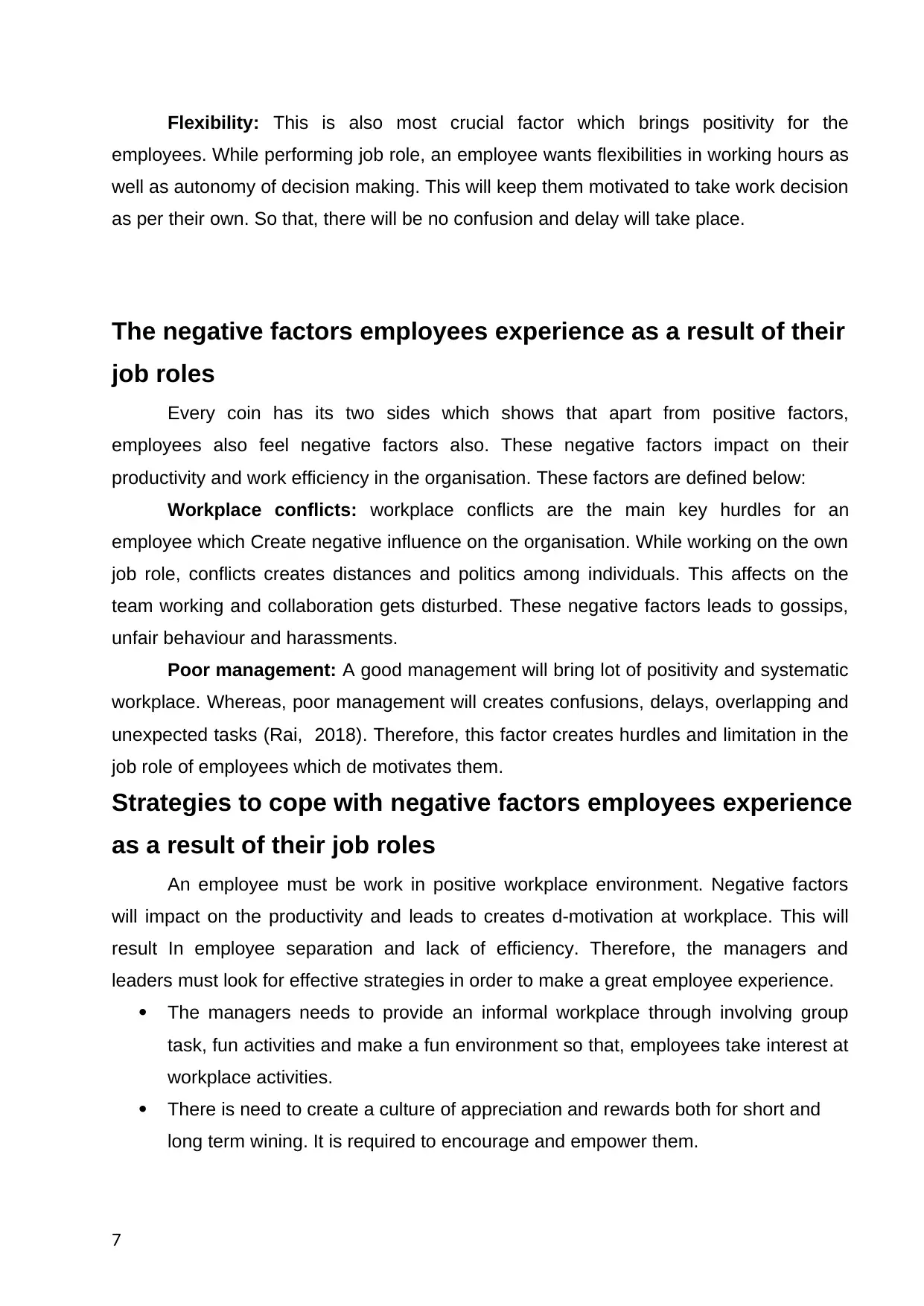
Flexibility: This is also most crucial factor which brings positivity for the
employees. While performing job role, an employee wants flexibilities in working hours as
well as autonomy of decision making. This will keep them motivated to take work decision
as per their own. So that, there will be no confusion and delay will take place.
The negative factors employees experience as a result of their
job roles
Every coin has its two sides which shows that apart from positive factors,
employees also feel negative factors also. These negative factors impact on their
productivity and work efficiency in the organisation. These factors are defined below:
Workplace conflicts: workplace conflicts are the main key hurdles for an
employee which Create negative influence on the organisation. While working on the own
job role, conflicts creates distances and politics among individuals. This affects on the
team working and collaboration gets disturbed. These negative factors leads to gossips,
unfair behaviour and harassments.
Poor management: A good management will bring lot of positivity and systematic
workplace. Whereas, poor management will creates confusions, delays, overlapping and
unexpected tasks (Rai, 2018). Therefore, this factor creates hurdles and limitation in the
job role of employees which de motivates them.
Strategies to cope with negative factors employees experience
as a result of their job roles
An employee must be work in positive workplace environment. Negative factors
will impact on the productivity and leads to creates d-motivation at workplace. This will
result In employee separation and lack of efficiency. Therefore, the managers and
leaders must look for effective strategies in order to make a great employee experience.
The managers needs to provide an informal workplace through involving group
task, fun activities and make a fun environment so that, employees take interest at
workplace activities.
There is need to create a culture of appreciation and rewards both for short and
long term wining. It is required to encourage and empower them.
7
employees. While performing job role, an employee wants flexibilities in working hours as
well as autonomy of decision making. This will keep them motivated to take work decision
as per their own. So that, there will be no confusion and delay will take place.
The negative factors employees experience as a result of their
job roles
Every coin has its two sides which shows that apart from positive factors,
employees also feel negative factors also. These negative factors impact on their
productivity and work efficiency in the organisation. These factors are defined below:
Workplace conflicts: workplace conflicts are the main key hurdles for an
employee which Create negative influence on the organisation. While working on the own
job role, conflicts creates distances and politics among individuals. This affects on the
team working and collaboration gets disturbed. These negative factors leads to gossips,
unfair behaviour and harassments.
Poor management: A good management will bring lot of positivity and systematic
workplace. Whereas, poor management will creates confusions, delays, overlapping and
unexpected tasks (Rai, 2018). Therefore, this factor creates hurdles and limitation in the
job role of employees which de motivates them.
Strategies to cope with negative factors employees experience
as a result of their job roles
An employee must be work in positive workplace environment. Negative factors
will impact on the productivity and leads to creates d-motivation at workplace. This will
result In employee separation and lack of efficiency. Therefore, the managers and
leaders must look for effective strategies in order to make a great employee experience.
The managers needs to provide an informal workplace through involving group
task, fun activities and make a fun environment so that, employees take interest at
workplace activities.
There is need to create a culture of appreciation and rewards both for short and
long term wining. It is required to encourage and empower them.
7
Paraphrase This Document
Need a fresh take? Get an instant paraphrase of this document with our AI Paraphraser
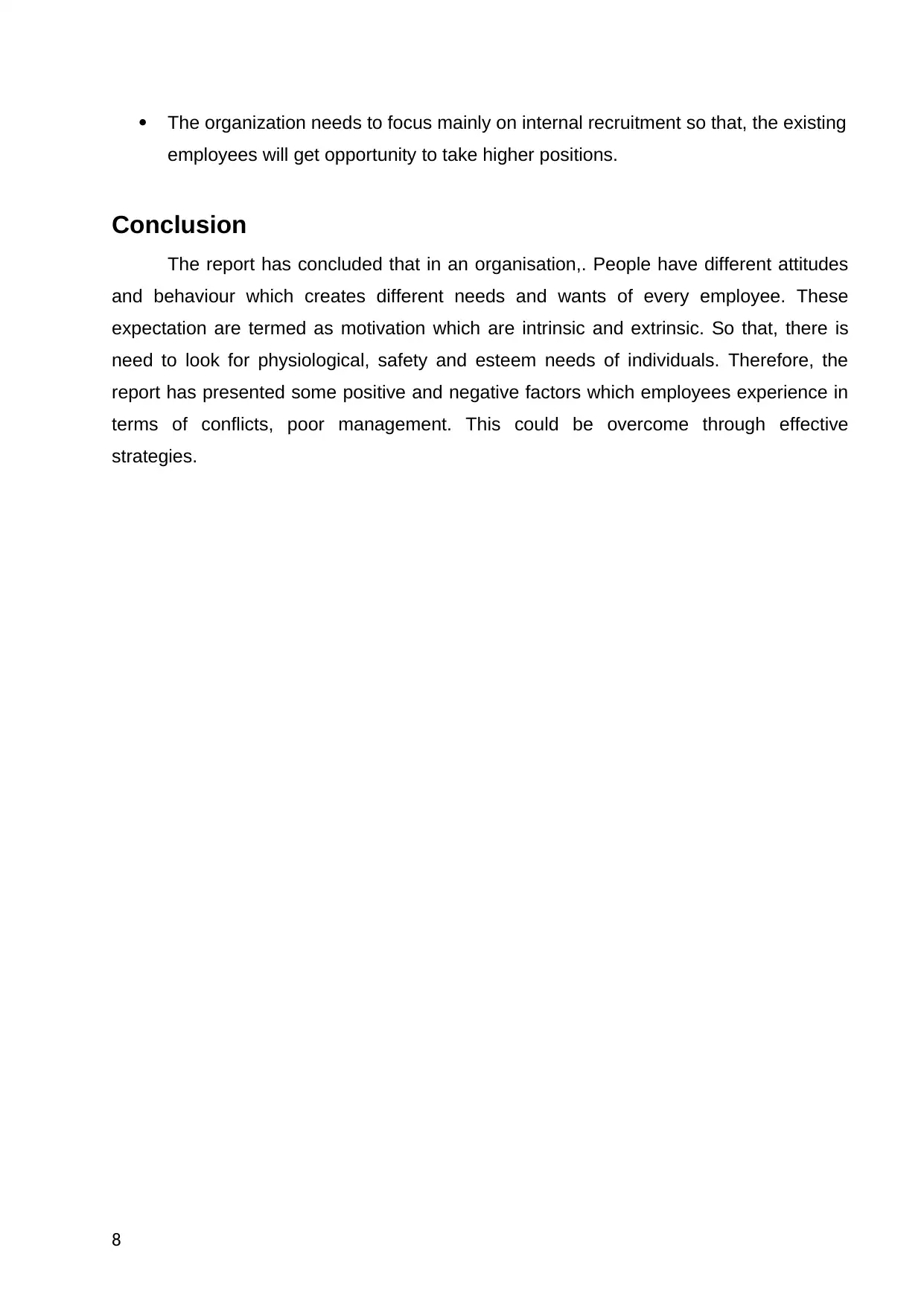
The organization needs to focus mainly on internal recruitment so that, the existing
employees will get opportunity to take higher positions.
Conclusion
The report has concluded that in an organisation,. People have different attitudes
and behaviour which creates different needs and wants of every employee. These
expectation are termed as motivation which are intrinsic and extrinsic. So that, there is
need to look for physiological, safety and esteem needs of individuals. Therefore, the
report has presented some positive and negative factors which employees experience in
terms of conflicts, poor management. This could be overcome through effective
strategies.
8
employees will get opportunity to take higher positions.
Conclusion
The report has concluded that in an organisation,. People have different attitudes
and behaviour which creates different needs and wants of every employee. These
expectation are termed as motivation which are intrinsic and extrinsic. So that, there is
need to look for physiological, safety and esteem needs of individuals. Therefore, the
report has presented some positive and negative factors which employees experience in
terms of conflicts, poor management. This could be overcome through effective
strategies.
8
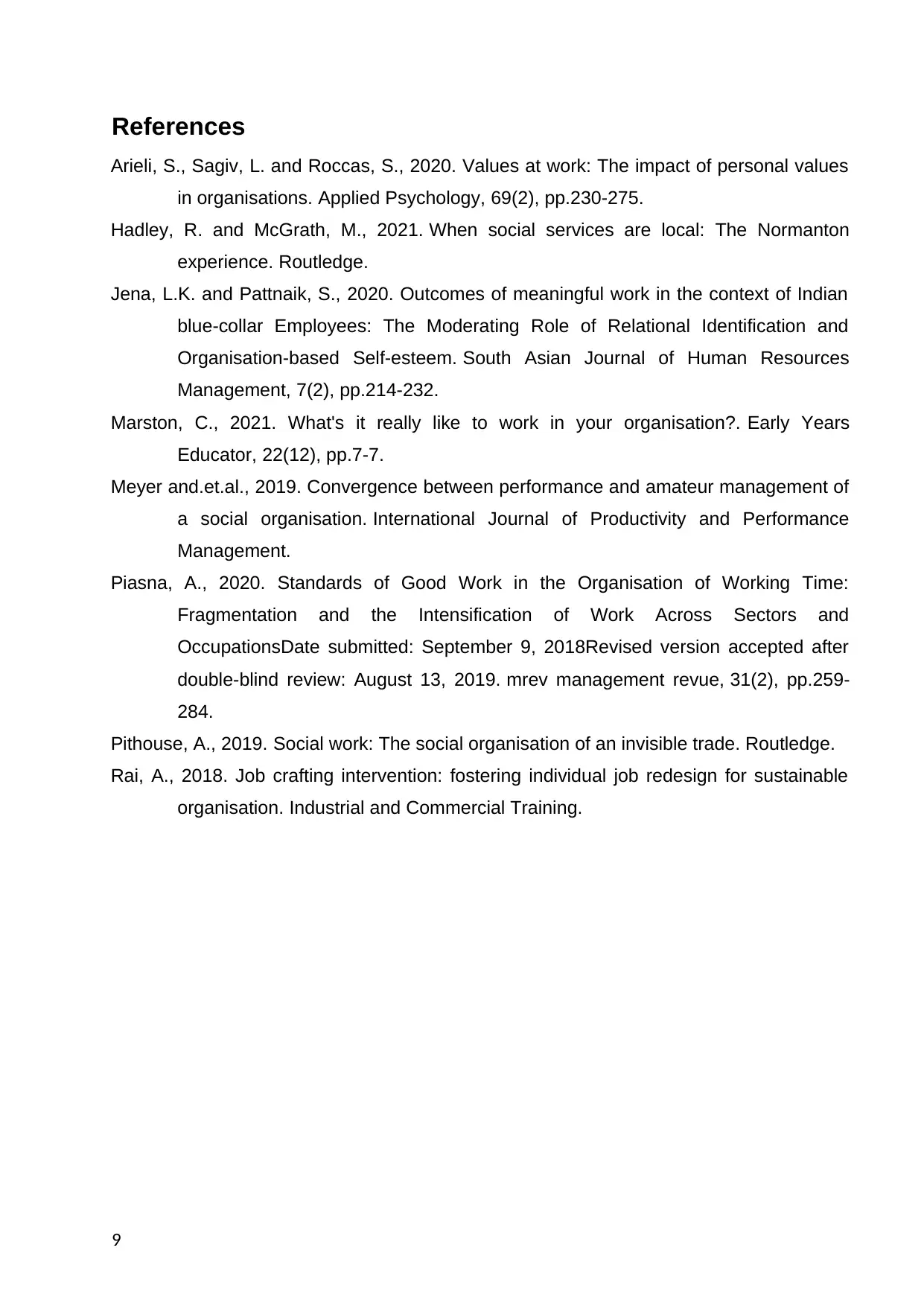
References
Arieli, S., Sagiv, L. and Roccas, S., 2020. Values at work: The impact of personal values
in organisations. Applied Psychology, 69(2), pp.230-275.
Hadley, R. and McGrath, M., 2021. When social services are local: The Normanton
experience. Routledge.
Jena, L.K. and Pattnaik, S., 2020. Outcomes of meaningful work in the context of Indian
blue-collar Employees: The Moderating Role of Relational Identification and
Organisation-based Self-esteem. South Asian Journal of Human Resources
Management, 7(2), pp.214-232.
Marston, C., 2021. What's it really like to work in your organisation?. Early Years
Educator, 22(12), pp.7-7.
Meyer and.et.al., 2019. Convergence between performance and amateur management of
a social organisation. International Journal of Productivity and Performance
Management.
Piasna, A., 2020. Standards of Good Work in the Organisation of Working Time:
Fragmentation and the Intensification of Work Across Sectors and
OccupationsDate submitted: September 9, 2018Revised version accepted after
double-blind review: August 13, 2019. mrev management revue, 31(2), pp.259-
284.
Pithouse, A., 2019. Social work: The social organisation of an invisible trade. Routledge.
Rai, A., 2018. Job crafting intervention: fostering individual job redesign for sustainable
organisation. Industrial and Commercial Training.
9
Arieli, S., Sagiv, L. and Roccas, S., 2020. Values at work: The impact of personal values
in organisations. Applied Psychology, 69(2), pp.230-275.
Hadley, R. and McGrath, M., 2021. When social services are local: The Normanton
experience. Routledge.
Jena, L.K. and Pattnaik, S., 2020. Outcomes of meaningful work in the context of Indian
blue-collar Employees: The Moderating Role of Relational Identification and
Organisation-based Self-esteem. South Asian Journal of Human Resources
Management, 7(2), pp.214-232.
Marston, C., 2021. What's it really like to work in your organisation?. Early Years
Educator, 22(12), pp.7-7.
Meyer and.et.al., 2019. Convergence between performance and amateur management of
a social organisation. International Journal of Productivity and Performance
Management.
Piasna, A., 2020. Standards of Good Work in the Organisation of Working Time:
Fragmentation and the Intensification of Work Across Sectors and
OccupationsDate submitted: September 9, 2018Revised version accepted after
double-blind review: August 13, 2019. mrev management revue, 31(2), pp.259-
284.
Pithouse, A., 2019. Social work: The social organisation of an invisible trade. Routledge.
Rai, A., 2018. Job crafting intervention: fostering individual job redesign for sustainable
organisation. Industrial and Commercial Training.
9
⊘ This is a preview!⊘
Do you want full access?
Subscribe today to unlock all pages.

Trusted by 1+ million students worldwide
1 out of 9
Related Documents
Your All-in-One AI-Powered Toolkit for Academic Success.
+13062052269
info@desklib.com
Available 24*7 on WhatsApp / Email
![[object Object]](/_next/static/media/star-bottom.7253800d.svg)
Unlock your academic potential
Copyright © 2020–2025 A2Z Services. All Rights Reserved. Developed and managed by ZUCOL.



